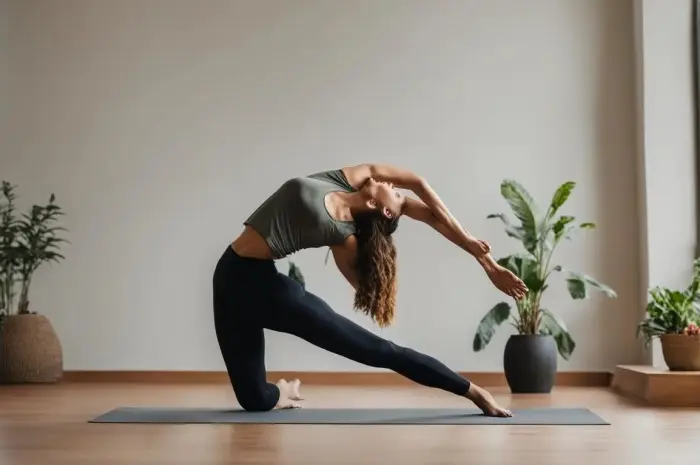Vinyasa yoga, renowned for its flowing sequences and mindful breathwork, offers a diverse range of poses that create a dynamic and transformative practice. These poses, combined with the synchronized movement and breath.
Allow practitioners to cultivate strength, flexibility, and mindfulness. In this comprehensive article, we will explore a selection of key vinyasa yoga poses, their benefits, and how they contribute to the overall experience of this vibrant yoga style.
Sun Salutations: Surya Namaskar
Sun Salutations, or Surya Namaskar, are the foundation of vinyasa yoga sequences. They consist of a series of poses performed in a flowing sequence, integrating breath and movement. Sun Salutations help to warm up the body, increase circulation.
And prepare for the practice ahead. They typically include poses such as Mountain Pose (Tadasana), Forward Fold (Uttanasana), Plank Pose (Phalakasana), and Upward Facing Dog (Urdhva Mukha Svanasana), among others.
Standing Poses: Building Stability and Strength
1. Warrior I (Virabhadrasana I)
This pose strengthens the legs, opens the hips, and stretches the chest and shoulders. It cultivates balance, stability, and a sense of groundedness.
2. Warrior II (Virabhadrasana II)
Warrior II builds strength in the legs and core while opening the hips and chest. This pose enhances stability, stamina, and focus.
3. Triangle Pose (Trikonasana)
Triangle Pose stretches the hamstrings, opens the hips, and improves spinal alignment. It also strengthens the legs and promotes balance and concentration.
4. Extended Side Angle Pose (Utthita Parsvakonasana)
This pose stretches the side body, opens the hips, and strengthens the legs and core. It enhances balance and stability while improving flexibility.
Balancing Poses: Cultivating Focus and Stability
1. Tree Pose (Vrksasana)
Tree Pose improves balance, strengthens the legs, and enhances focus. It also stretches the hips and inner thighs, promoting stability and a sense of grounding.
2. Eagle Pose (Garudasana)
Eagle Pose builds strength and flexibility in the legs, shoulders, and hips. It also improves balance, concentration, and joint mobility.
3. Dancer’s Pose (Natarajasana)
Dancer’s Pose challenges balance, strengthens the legs, and opens the shoulders and chest. It promotes flexibility, grace, and poise.
4. Crow Pose (Bakasana)
Crow Pose develops upper body strength, core stability, and balance. It also cultivates focus, body awareness, and coordination.
Seated Poses: Deepening Flexibility and Relaxation
1. Seated Forward Bend (Paschimottanasana)
This pose stretches the hamstrings, lengthens the spine, and calms the mind. It promotes flexibility, relaxation, and introspection.
2. Bound Angle Pose (Baddha Konasana)
Bound Angle Pose opens the hips, stretches the inner thighs, and improves posture. It stimulates the abdominal organs and encourages a sense of surrender and release.
3. Seated Twist (Ardha Matsyendrasana)
Seated Twist releases tension in the spine, stretches the hips and shoulders, and aids in digestion. It promotes detoxification, flexibility, and spinal mobility.
4. Lotus Pose (Padmasana)
Lotus Pose is a classic seated posture that promotes a calm and meditative state. It stretches the hips and ankles, improves posture, and cultivates inner stillness.
Backbends: Expanding the Heart and Cultivating Energy
1. Cobra Pose (Bhujangasana)
Cobra Pose strengthens the back muscles, opens the chest, and improves spinal flexibility. It also stimulates the abdominal organs and promotes energy flow.
2. Upward Facing Dog (Urdhva Mukha Svanasana)
Upward Facing Dog strengthens the arms, wrists, and back while opening the chest and shoulders. It invigorates the body, improves posture, and enhances mood.
3. Wheel Pose (Urdhva Dhanurasana)
Wheel Pose is an advanced backbend that opens the chest, strengthens the arms and legs, and increases spinal flexibility. It promotes courage, energy, and a sense of liberation.
4. Fish Pose (Matsyasana)
Fish Pose stretches the chest, throat, and abdomen, releasing tension and improving posture. It promotes deep breathing, rejuvenation, and emotional balance.
Conclusion
Vinyasa yoga offers a vast array of poses that engage the body, mind, and spirit. These poses, coupled with the rhythmic flow of breath and movement, enable practitioners to develop strength, flexibility, balance, and mindfulness.
Whether it’s the empowering standing poses, the grounding seated poses, or the heart-opening backbends, each pose in vinyasa yoga contributes to a holistic practice that supports overall well-being and inner growth. Embrace the beauty and fluidity of vinyasa yoga, explore these poses with intention and awareness, and allow the practice to unfold as a transformative journey.


